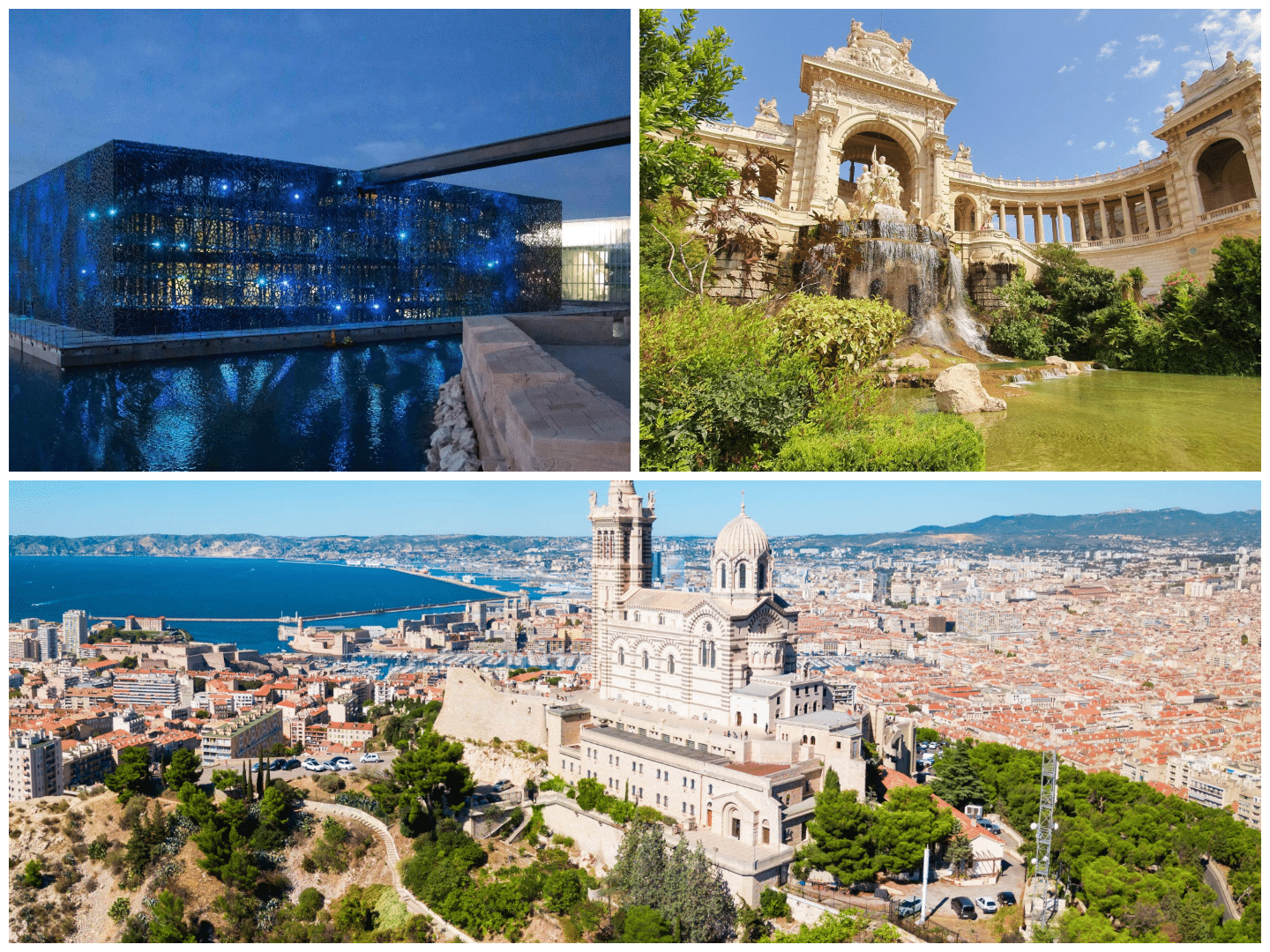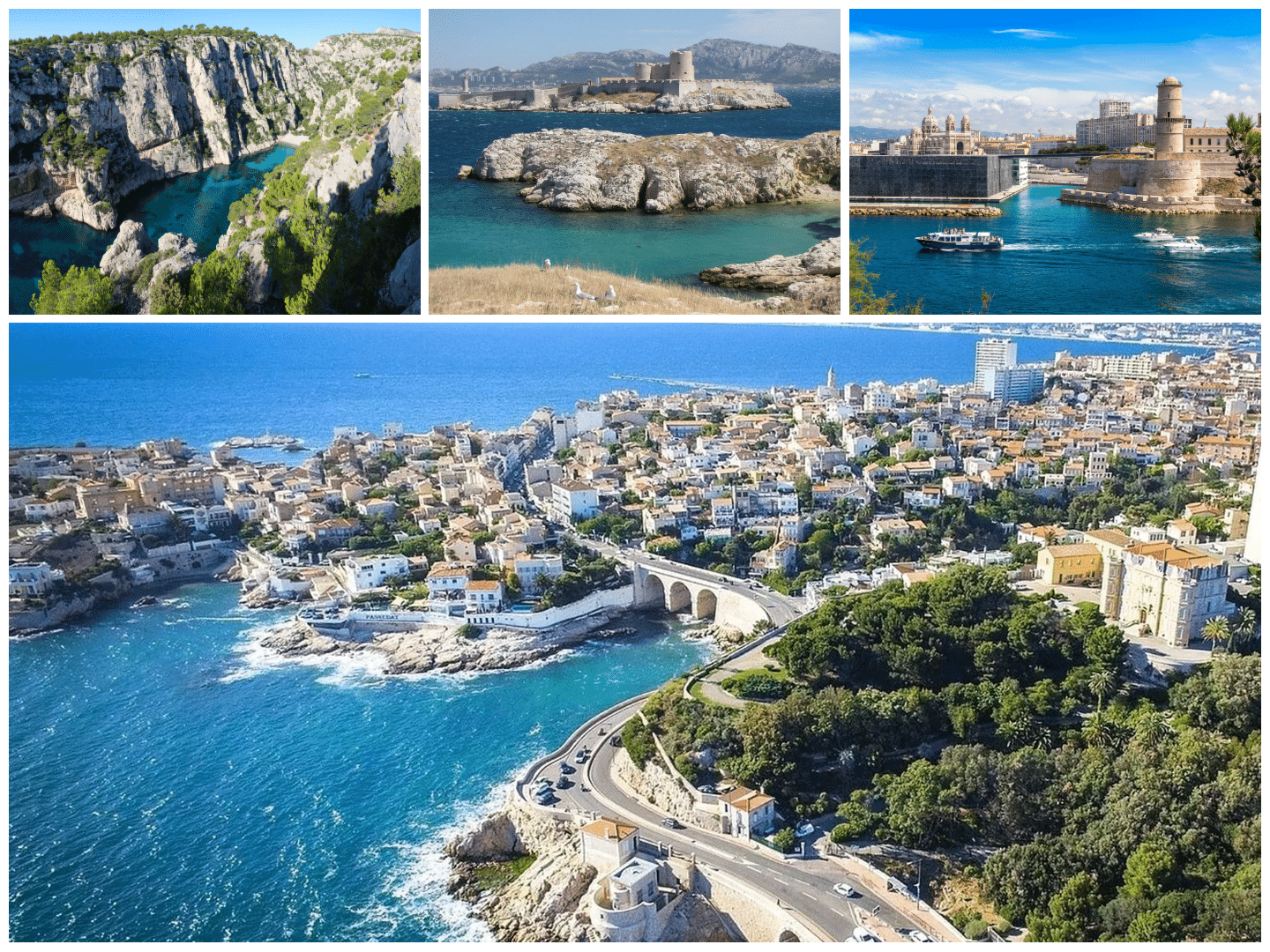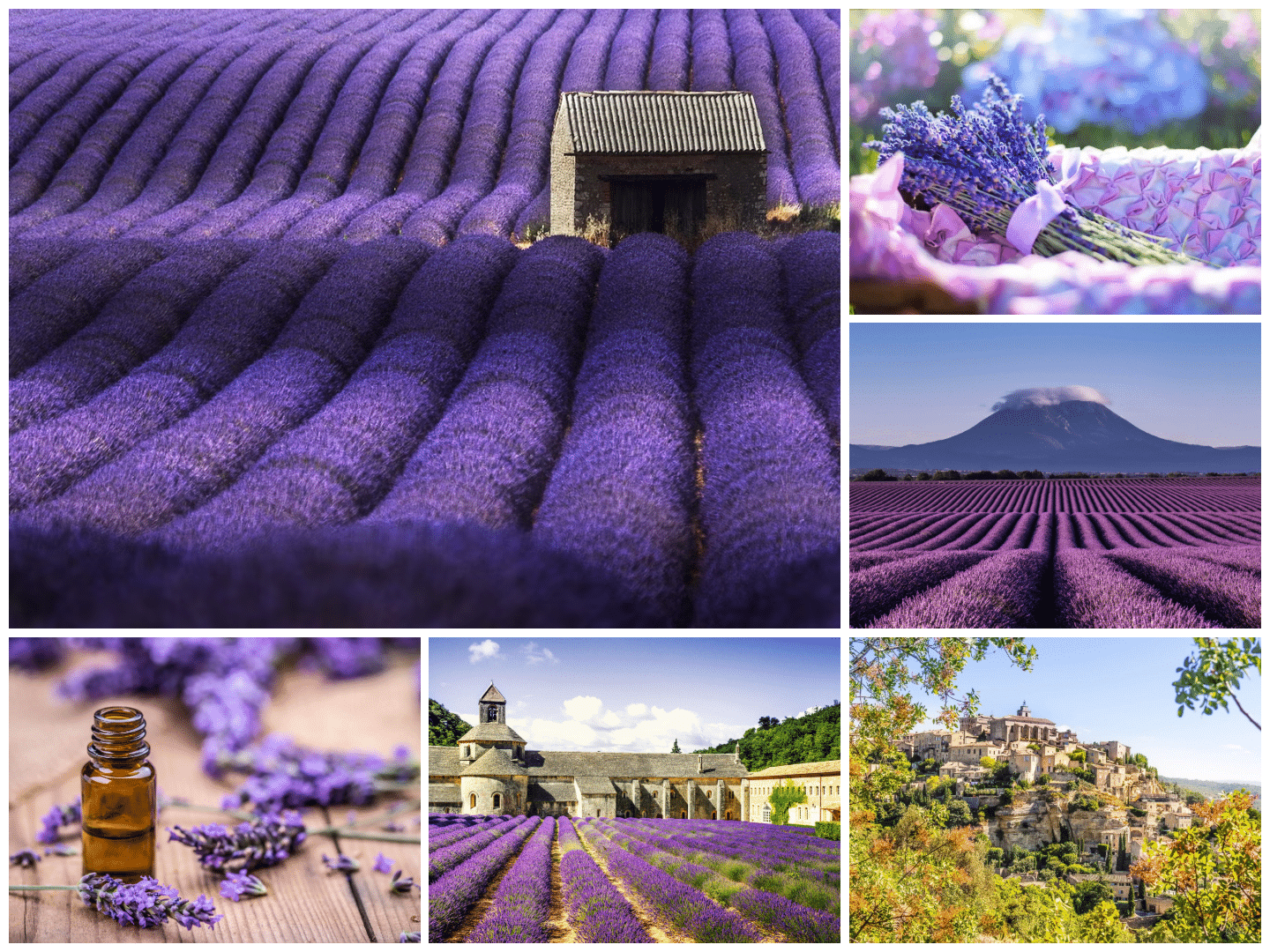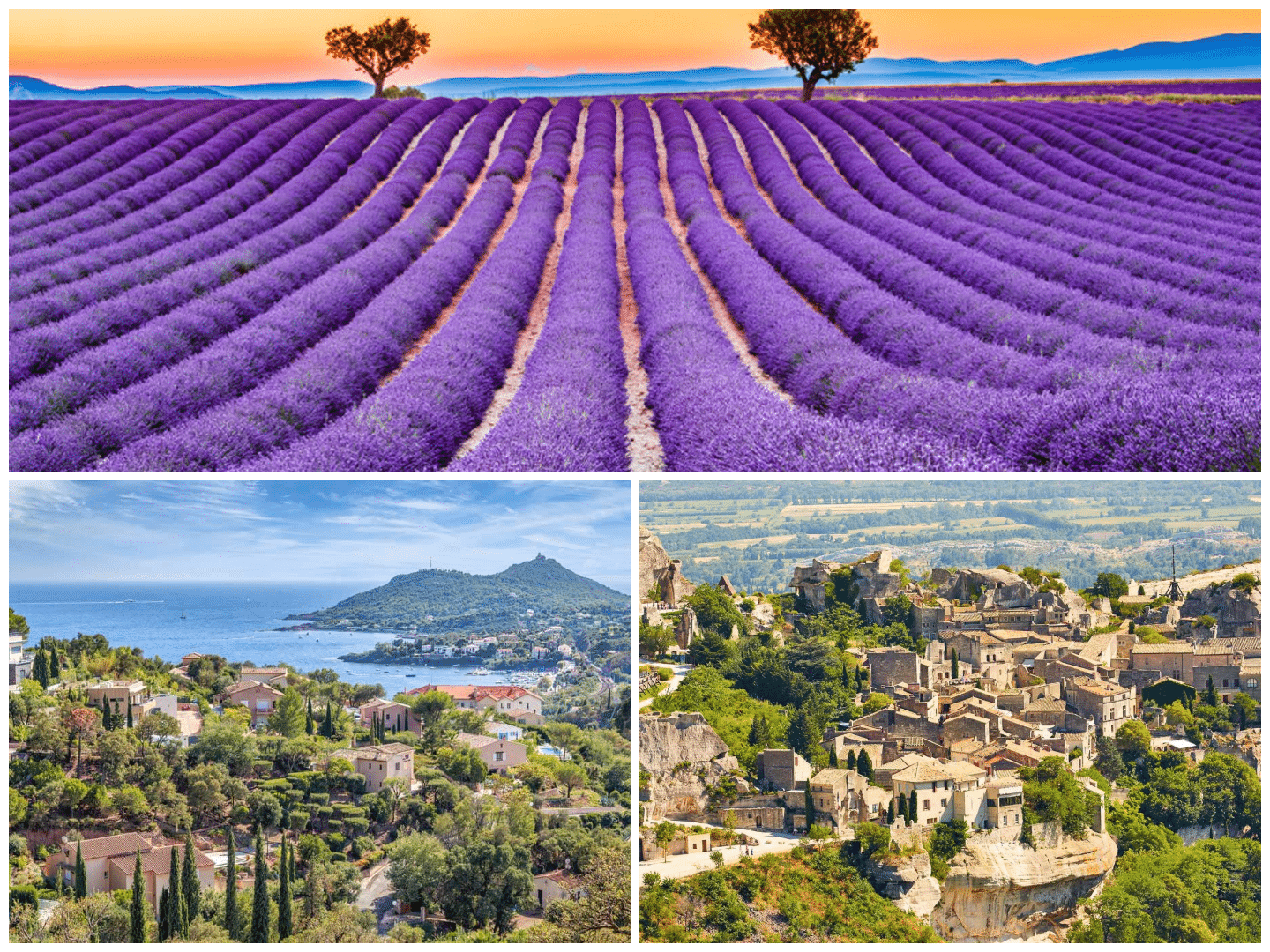In this Marseille guide, “The Top Things to Do in Marseille,” we highlight the must-see attractions and activities in this magnificent French city. We’ll provide essential information on how to get there, where to stay, and helpful tips to ensure your visit is exceptional.

The famous Basilica of Notre-Dame de la Garde overlooks Marseille. The Palais Longchamp is another must-visit site in the city. It features a beautiful park and serves as a historic monument built to supply water to Marseille. Additionally, the Mucem Museum is a must-see destination for those interested in architecture and heritage.
©Adobe Stock, marseille-tourisme.com, and Steven Massart
Our website includes affiliate links. So, remember that we may receive commissions when you click our links and make purchases. Please read our legal disclaimer document for more information about our Affiliate disclaimer and other disclaimers like the Fair-Use disclaimer.
Why Go To Marseille
Firstly, in this Marseille guide, we will show you the main reasons why you should visit this bustling southern French municipality.
Founded 2,600 years ago as a port city, Marseille remains a dazzling metropolis in France on the Mediterranean, especially after its turn as the European Capital of Culture in 2013. With some of its rough edges polished, a smattering of new museums, and a handful of Michelin-starred restaurants, France’s second-largest city (after Paris) is making a comeback.
Marseille’s long, vibrant history and hilly landscape of gritty streets and whitewashed buildings that tumble to the yacht-filled waters add to its allure. It seems possible to stumble on something secret, something all your own—something not listed in the travel books. But you’d better hurry: The world seems to be catching on.
Top things to do in Marseille
From the top of its hill, the famous Basilica watches over the people of Marseille.
Notre-Dame de la Garde symbolizes Marseille, overlooking sailors, fishermen, and the people. When you visit, see “la Bonne Mère” or “The Good Mother.” You’ll enjoy stunning views of the city and the Mediterranean Sea from the top.
This Basilica is the most popular site in Marseille. It is known for its beautiful architecture and 360-degree views. You can reach it by walking or taking a tourist train, which avoids the uphill climb.
The statue of the Virgin is currently under restoration until October 2025, so it is not visible at this time.
Here are some ways to visit the Basilica:
- Walk from the Vieux-Port for a 45-minute uphill trek.
- Take the number 60 bus from Mucem or other nearby locations to the base of the stairs.
- Enjoy a Tuk Tuk ride from the Old Port, a guided tour, and a stop at the Basilica.
- Drive to the foot of the Basilica, but be aware that parking fills up quickly in summer.

Explore the stunning Calanques cliffs, a magnificent natural wonder between Marseille and La Ciotat. Just two miles from the vibrant Vieux Port, a rocky fortress recalls the tales of Edmond Dantès, famously known as the Count of Monte Cristo. The Vieux Port of Marseille and the iconic Notre-Dame de la Garde serve as powerful symbols of the city.
©Wikipedia
Marseille’s guide recommends wandering in the Le Panier district.
Visit Marseille’s oldest district, known as the Panier. Here, you can explore narrow streets with a friendly atmosphere, cozy café terraces, colorful street art, and unique shops. Be ready for some stairs, but the climb is worth it for the local Mediterranean spirit and beautiful sea views.
The Panier is a must-see in Marseille. The Greeks founded it over 2,600 years ago because of its hillside location. Moreover, you can check out historical sites like the Agora at Place de Lenche and the Vieille-Charité, built in the 18th century. The area has returned to life after a decline in the late 20th century. It is now full of artists, shops, and cultural attractions.
One of the must-see attractions is the Maison Diamantée, built by wealthy Spanish and Italian traders. The building has a beautiful facade of diamond-shaped stones. It was saved from demolition in 1943 and is now an important historical site. Experience the colorful charm of Marseille’s old town!
Place de Lenche is at the old Greek Agora, where people once watched port activities. The square, initially enclosed, features the convent of Saint-Sauveur, founded by Saint Cassien in the 5th century, across from the Saint-Victor monastery.
Beneath the square are vaults of Saint-Sauveur that likely served as water tanks in the 3rd century BC. These vaults were recognized as Historical Monuments in 1840 and remain well-preserved but inaccessible. The name “Lenche“ comes from the Lincio family, which is known for its coral workshop and contributions to the city.
The southern part of the square was destroyed in 1943 due to German plans, and it was rebuilt in the 1950s.
The ‘Palais Longchamp’, Marseille’s water reservoir
The Palais Longchamp is a must-visit site in Marseille. It features a lovely park and is a historic monument built to supply water to the city.
In 1835, Marseille experienced a cholera outbreak due to a water shortage. In response, the city hired architect Franz Mayor de Montricher. He was tasked with a project that began in the 16th century: digging an 85-kilometer canal to transport water from the Durance River to Marseille.
After ten years of hard work, 18 aqueduct bridges were constructed to deliver drinking water to the city. Architect Henry Espérandieu, known for building the Notre-Dame Basilica, designed the impressive Longchamp monument to mark the arrival of water, which took place from 1682 to 1869.
Did you know?
From 1855 to 1987, the Palais Longchamp inspired wonder as it housed Marseille, France’s first provincial zoo, known as the Big Zoo. The remnants of animal cages and the giraffe building still stand as a testament to its rich history, with preserved creatures now exhibited in the Natural History Museum.
Established in 1864, the observatory is Marseille’s oldest scientific building and embodies the spirit of exploration. It was once home to the world’s largest telescope. It was a discovery hub for over 140 years before researchers ventured to Château-Gombert.
Today, this vibrant area invites the public to engage with the cosmos through astronomy-oriented activities, such as planetarium visits and enlightening lectures. It’s a perfect setting for families to inspire curiosity and create lasting memories while visiting Marseille!
The Mucem Museum – Visit the Mecca of architecture and heritage
The Mucem, covering nearly 45,000 square meters across three locations, is a must-visit in Marseille.
It is located at the port’s entrance, on the J4 harbor mole, and in Fort Saint-Jean, essential sites for the city’s development.
The Museum of European and Mediterranean Civilizations opened on June 7, 2013. It is the first major national museum focused on Mediterranean civilizations for the 21st century. Directed by Bruno Suzzarelli, it quickly became one of the most popular museums in Marseille. The museum’s collections are kept at the ‘Belle de Mai’ in the Conservation and Resource Center.
Taste a local food
The next thing we wanted to reveal in our Marseille guide is that the city is a Mecca for food lovers! The city bursts with flavors, creativity, and vibrant atmospheres in its gastronomy! Whether you’re seeking a delightful lunch or dinner at a restaurant, craving tapas while soaking in stunning views from a rooftop, enjoying a drink at one of the many charming cafés, bars, and pubs, or embarking on an exciting culinary adventure with cooking classes, Marseille’s culinary landscape will exceed all expectations. A must-try dish in Marseille, bouillabaisse—the quintessential Mediterranean fish stew—has recently been celebrated as one of the 20 best soups in the world! In this dynamic city, you can savor it in both traditional and innovative styles, from star-rated restaurants to even as a sandwich! Revel in a warm, communal meal in the Vallon des Auffes, around the Old Port, or amidst the breathtaking scenery of a Calanque.
Discover the surroundings
Get ready for an exhilarating adventure as we dive into a selection of thrilling day tours from Marseille! Each experience promises a captivating mix of culture, rich history, and stunning landscapes. Picture yourself meandering through the vibrant lavender fields near Aix-en-Provence or paddling through the crystal-clear waters of Verdon Gorge. These incredible excursions are your ticket to discovering the hidden treasures that this enchanting region has to offer. Grab your bags and prepare for an unforgettable journey around Marseille! If you want to learn more and the Marseille guide didn’t provide enough information, we recommend reading our related articles about Provence. You won’t regret it.
Note: If you’d like to discover more about traveling to Provence, we recommend reading our related article.
Enjoy A natural wonder – The Calanques National Park.
Discover the marvelous Calanques cliffs, a breathtaking natural wonder located between Marseille and La Ciotat. This stunning scenery is not just a sight to behold; it’s an experience you can’t afford to miss! With its seamless blend of pebble and sandy beaches alongside miniature fjords showcasing turquoise waters, this biodiverse gem looks straight out of a postcard. It’s the perfect place to relax in the sun, dive into the vibrant underwater world, or indulge in exhilarating water sports like kayaking.
Whether you’re planning an epic hike or want to soak in the serene beauty of nature, the Calanques will exceed your expectations. While some are family-friendly and easily accessible, others may challenge you with rugged trails that reward your effort with unparalleled views. As you explore this unique location, you’ll be captivated by its stunning landscapes. Experience the magic of the Calanques—an unforgettable highlight of any trip to Marseille!
Get to know Marseille’s old port.
The ‘Vieux Port’ of Marseille, alongside the iconic Notre-Dame de la Garde, stands as a powerful city symbol, nestled at the base of the renowned Canebière. This vibrant hub is not just a beautiful sight; it is the heart of Marseille, where people gather, celebrate significant events, and enjoy spectacular fireworks—a true landmark cherished by all Marseillais! In history, the Old Port marks the birthplace of the ancient Greek colony of Massalia, which evolved into the Roman city of Massilia. A medieval town, Arles, developed around it. The formidable Saint-Nicolas and Saint-Jean forts meticulously safeguarded this historic port. With its orientation towards the Mediterranean Sea and framed by stunning limestone cliffs, the ‘Vieux Port’ has been a vital center for trade, establishing connections with distant lands over the centuries.
A notable feature that once graced the Old Port was the elegant transporter bridge. Since its inauguration in 1905, it has united the two forts, although it was sadly destroyed in the wake of the Second World War.
In 2013, the Old Port underwent a remarkable renovation, coinciding with Marseille’s recognition as the European Capital of Culture. This transformation improved accessibility, reduced traffic congestion, and introduced a stunning shade house designed by architect Norman Foster. Today, the Vieux Port remains a lively epicenter of Marseille, lovingly watched over by Notre-Dame de la Garde. Embrace the spirit of this magnificent city at its most vibrant!
Did you know?
The legend of Gyptis and Protis tells how Marseille (Massalia) was founded around 600 BC by Greek settlers from Phocaea. This story has been shared since the 3rd century BC. It describes the marriage of Gyptis, the daughter of Nann, the leader of the native Segobridge, to Protis, a sailor from Phocaea. Gyptis chooses to marry Protis during the wedding feast by giving him a goblet filled with water. This legend highlights Marseille’s history as a welcoming city for newcomers. Today, tourism connects back to this story.
Sample regional food and wine in Aix-en-Provence
Marseille is not just about Marseille if you know what we mean. It is also about its surroundings. That’s why our Marseille guide will reveal some of the best things to do outside this city.
Aix-en-Provence may not be as romantic as it once was, but wandering its narrow streets in the early morning feels like stepping back in time when poetry was common. Sitting in a small square at night, you can watch fountains spray water and see petals from a discarded flower on the cobblestones.
Today, the main reasons to visit Aix are shopping, enjoying café culture, and exploring the grand food market, which features regional produce. Have a relaxing lunch under a parasol, then visit one of the fantastic wineries nearby. For instance, drive into Cezanne country and buy wine from a vineyard like the Domaine des Masques. This experience is about the trip as much as it is about the wine. For a few hours, you can feel like you’re in a Godard movie, imagining yourself as Alain Delon or Anna Karina.
To get to Aix-en-Provence from Marseille, drive north on the A55 and A51 for about 30 minutes or take a bus from Gare St-Charles, which takes around 50 minutes.
Note: Please read our related article: Winetasting in Provence.
Château d’If
Just two miles from the vibrant Vieux Port, a rocky fortress beckons, immortalized by the legendary Edmond Dantès, also known as the Count of Monte Cristo. Completed in 1531, its three majestic stone towers and imposing walls tell stories of resilience. Explore the prison cells and ramparts on a self-guided tour and feel the echoes of adventure and transformation.
Best Months to Visit
The best time to visit Marseille is from September to November when tourists visiting during the peak season of May to August have returned home, freeing up the beaches, attractions, and accommodations. The months from December to March are low season, characterized by average temperatures in the 40s and an emptied-out city. April is another nice time of year, when travelers may see discounted rates on flights and rooms, along with pleasant weather and relatively thin crowds.
How to Get to Marseille
Here are a few details for your stay in Marseille and how to get there.
Marseille Provence Airport is the closest airport, located 27km northwest of the city. It is France’s fifth busiest airport and has many flights from Europe. There are no direct flights from the USA, but you can connect through London, Paris, or Dublin. The Navette Marseille Aeroport bus takes you to Gare Saint-Charles every 15 minutes. It takes about 25 minutes. There is also a free shuttle to Vitrolles Aeroport Marseille Provence, where you can catch a direct train to the central train station.
If you are already in Europe, the train is an easy way to reach Marseille. The central train station is Gare de Marseille St Charles, which serves most trains. The direct train from Paris takes 3 hours and 15 minutes. The train from Marseille to Nice takes about 2 hours and 48 minutes. Marseille’s central bus station, St Charles, is behind the train station and offers buses to multiple European destinations. You can also use the local transport service, RTM, to move around the city. However, if you prefer more freedom, you can rent a car.
Getting Around Marseille
The best way to get around Marseille is on foot since most neighborhoods are pedestrian-friendly and easy to navigate. However, the metro and tram lines are fast, affordable, and efficient. Driving around the city, however, is not recommended since parking can be a hassle. Taxis (or Uber) are another option, but fares can increase quickly. The city’s bike-sharing program is also a transportation option.
Visitors usually fly to the Marseille-Provence Airport (MRS), less than 20 miles northwest of the city, to reach Marseille. To travel from the airport to Marseille, visitors can hop aboard a shuttle bus, which costs 8.30 euros (about $10) for a one-way fare, or rent a car. Taxis from the airport to the city center cost 50 euros (about $60) during the day and 60 euros (approximately $72) at night.
Where to stay in Marseille
The Vieux Port (Old Port) area is the center of Marseille, where you’ll find most hotels, attractions, and entertainment. It is the best place to stay because it’s central, quiet in the evenings, and you can easily walk to the main sights. The area has many pedestrian streets, and the metro makes reaching other parts of the city and the airport easy. You can also take boat tours from the docks to see the city from the water or visit the Calanques. Consequently, accommodation in Vieux Port is often more expensive.
La Canebière is another option; it’s busier but family-friendly, especially in the Thiers area with parks and green spaces. North of the Old Port, Le Panier is a trendy neighborhood with colorful alleys, street art, shops, and art galleries. It’s also home to the Centre de la Vieille Charitée, which features essential museums.
Neighborhoods like La Joilette, L’Estaque, and Roucas-Blanc offer budget travelers good amenities and transport links. If you have kids, La Plage and L’Estaque are excellent choices because of the nearby parks and beaches. Rive Neuve, south of the Old Port, has beautiful neoclassical buildings and attractions like the Abbey of Saint Victor and the Opéra de Marseille. This area also has nightlife and restaurants just a short walk from Vieux Port.
Marseille is great for a 2-3 day stay and is a good base for exploring nearby places like Sault and the lavender fields or Avignon. If you plan to spend more time in those areas, consider staying elsewhere and using Marseille for a day trip.
Note: Avoid the northern districts, especially arrondissements 13, 14, and 15, as they lack attractions.
When choosing an ideal accommodation, we advise you to consider your personal preferences. What do you like and prefer, and what kind of traveler are you? For instance, accommodation prices can be cheaper on the outskirts of a city; however, you will spend more time and money on transport. That’s why our guide recommends choosing your room wisely and carefully. The next thing we want to stress is safety. We constantly check which areas are safe to live in and which aren’t. After all, we are all traveling to have fun and not to be afraid to leave our rooms.
When talking about the type of travelers, we usually mean the following: Are you a solo traveler, LGBT+ traveler, a traveler with a family, etc.? For instance, if you are a solo traveler, consider hostels or other accommodations with organized social activity. But if you are an LGBT+ traveler, you will most likely want to stay in gay-friendly areas.
Lastly, when choosing your accommodation, always read the comments, owners’ reviews, etc. This will make your vacations much more pleasing and effortless.
Take a look at

Lavender Guide – Provence
This Provence lavender guide will provide you with information about this famous plant, its uses, and its history. Furthermore, we

How to plan your trip to Provence
Have you chosen Provence (France) as your next holiday destination? Here’s some information to help you decide how to get

Wine tasting in Provence
The South of France has always been known for its historic towns, villages, lavender fields, stunning natural landscapes, delicious food,
References and sources:
Photo credits:
Featured photo: Pixabay
